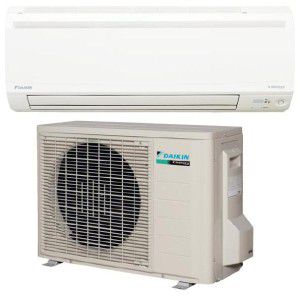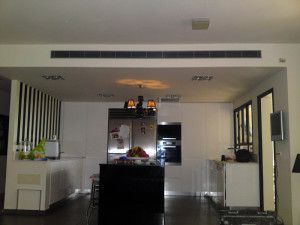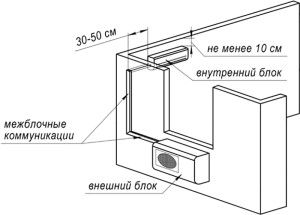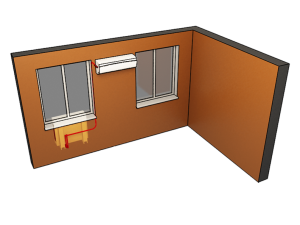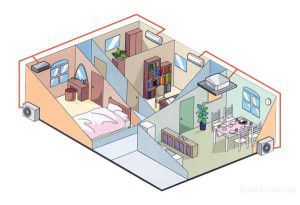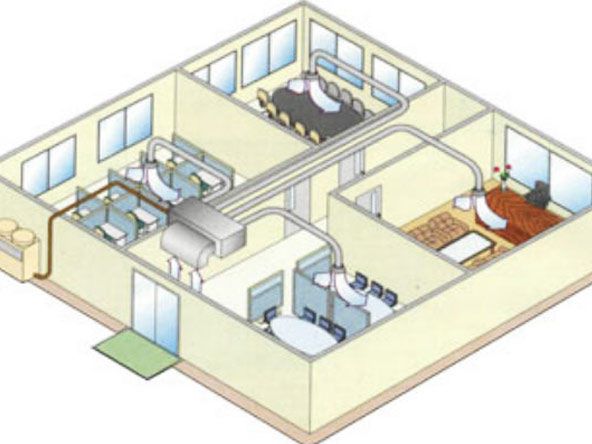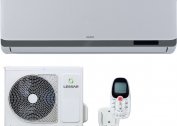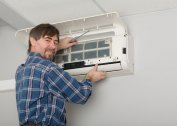When it comes to air conditioning in an apartment, the first question that arises is which technique to give preference to. Previously, buyers had little choice: mobile and window monoblock systems that could only cool the room, and even then they did not always do it fully and silently.
Today, the climate technology is so diverse that air conditioning in the apartment can be carried out using several types of split systems and a wide variety of mobile, window and evaporative units.
Types and types of air conditioners
Split systems for domestic and commercial use enjoy great success with buyers, namely:
- wall mounted;
- cassette
- channel;
- floor-to-ceiling (universal).
The split system is an air conditioner, divided into two parts: an evaporative indoor unit and a condenser outdoor module.
Wall conditioners
More often people install wall split systems in their homes, as they are cheaper and do not cause problems during installation or further maintenance. The indoor unit is attached to the wall on a special mounting plate and connected to the outside by means of wires and copper tubes, through which freon circulates.
Wall-mounted split systems can both cool and heat the room in the fall or spring, when there is no heating, but most of them can not be turned on in frosts below -5 ° C. It’s easy to choose an air conditioner for an apartment of any shape and area, since they have a wide range of sizes for refrigerating power and choosing the right one is easy. They are mounted in bedrooms, kitchens, hallways, living rooms and other rooms.
The air flow diverges parallel to the horizontal surface, but its direction can always be better changed manually or using the remote control. The concentration of cold is usually at a distance of 1.5-2 meters from the distribution dampers.
Floor and ceiling air conditioners
Universal or the so-called floor-to-ceiling split systems are very compact and similar in appearance to previous devices. Their main advantage is the dual installation. If the customer needs to place the indoor unit on the wall, then it is mounted at a distance of 15-20 cm from the floor in a suitable place. Air goes upward and is then distributed throughout the room. If it is not possible to mount the unit on the wall, it is fixed with special studs to the ceiling. Air in this case is distributed first along the ceiling, and then goes down. The outdoor module, like the wall split, is hung on the wall of the building or on the facade of the balcony.
Floor-and-ceiling devices are semi-industrial (commercial) refrigeration machines, since they have a higher power potential. They are often placed where the room has a complex configuration or panoramic glazing, which makes it impossible to fix the indoor unit as a standard and causing large heat losses in winter and accelerated heating in summer.
Some manufacturers call this type of conditioners console.
The opinion that, if desired, it is better to change the installation option for a universal split system, is wrong. It is mounted and becomes stationary, without suggesting any further alterations.
Both wall-mounted and universal split systems have a number of standard operating modes:
- cooling;
- heating (not always);
- ventilation;
- drainage;
- auto.
In automatic mode, the system itself selects the desired operating mode (cold or heat) with the most comfortable temperature. Typically, the instrument supports +20 + 22 ° C or as specified by the user.
As additional functions and options, a whole list of modern lotions can be attached, such as:
- turbo mode with accelerated access to the set parameters;
- comfortable / economical sleep mode with minimal energy consumption at night;
- timer for setting the time frame for turning on / off the air conditioner;
- fine filters - coal, catechin, ionizing, deodorizing, etc.
This is not a complete list of all the additional configurations of the described split systems. Typically, each manufacturer tries to equip their products with some new invention in order to stand out from the rest.
Cassette and duct air conditioners
Such types of air conditioners for the apartment as duct and cassette also do an excellent job of air conditioning, but they are installed in rooms with high ceilings (from 3 m) and require installation at the stage of repair work.
Cassette air conditioners differ from previous devices in that their indoor unit is a square module installed in a cell in a suspended ceiling, that is, this device has a hidden type of installation. Usually, only a decorative panel remains on the ceiling, through which air diffuses throughout the room. The most powerful flows are directed downward, and that is why such splits are not set in ordinary apartments with low ceilings. Air distribution is in 4 directions.
The cassette air conditioner has a drainage pump that pumps water 60 cm up from the ceiling level, after which it is necessary to lay a drain pipe at a slope of 1 cm by 1 meter in order to remove condensate from the system by gravity.
The cassette split system can be equipped with an infrared wired or wireless remote control.
Some models allow the installation of an air duct to mix atmospheric air. A connecting hole is cut in the housing opposite the drainage pipe or refrigerant piping, to which the insulation material, the flange, and then the mixing tube itself are fixed. The volume of air from the street will be about 10-20% of the total mass.
Ducted air conditioners also require hidden installation in the ceiling or wall. They are combined with a supply and exhaust system, due to which it is possible to mix fresh air in small volumes. Air flows can be directed from one indoor unit to several rooms along the air ducts. They go from the adapter to the supply and exhaust grille, which is also connected to it. Only these bars are visible in the room. Instruments are controlled either from a wired stationary or from an infrared wireless remote control.
Both channel and cassette split systems have standard operating modes, which can be supplemented by various functions and options such as a timer, anti-icing, restart, fine filters and so on.
Air conditioners for the apartment
How to choose an air conditioner for an apartment, and is it needed there at all? The second part of the question is always solved based on personal preferences and living conditions. When the housing is located on the shady side and can be regularly ventilated, there is no need to install an air conditioner in the apartment. The sunny side, the close proximity of the roof, panoramic windows that allow more heat to pass than ordinary double-glazed windows, noisy tracks under the windows - all these factors make residents think about the need for an air conditioner in the apartment, especially when there are young children and elderly people.
When the housing is located on the south side, the sun shines from morning to evening, so in summer it is impossible to cool off in the heat of air only, and if there is a road under the windows where cars constantly drive, the smell of exhaust gases is added.
Calculation of the cooling capacity of the air conditioner
When the decision on whether an air conditioner is needed in the apartment is made, it remains to choose a split system, calculate its power, and find a place to hang it.
First, the required cooling power is determined, which should not be confused with energy consumption from the mains.
Cooling capacity is the amount of cold generated by the device for a certain time at a certain energy consumption and expressed in kW.
If a person does not know how to calculate the air conditioning for an apartment, you can contact the company where you plan to install it, or use the online calculator service.
There are simple formulas for calculating the required power of a split system. As a rule, 1 kW of cooling capacity is laid on 10 m².
This gives approximate data for a room with an average heat gain. When calculating the air conditioner for an apartment on the south side, under a roof, with a large glazing area or a huge amount of constantly working equipment, from 10 to 30% from above is added to the result, which should cover the excess incoming heat.
Type of indoor unit
Now, having the necessary technical indicators, they are thinking about which air conditioner to choose for the apartment. In all simple cases, they acquire wall-mounted models, since they will cost the buyer quite cheaply. Housing in typical houses of Khrushchev, Brezhnev and modern buildings - these are ideal options for them.
Floor and ceiling air conditioning is needed if:
- high power is required for medium areas, but there are no false ceilings and false walls for installing a channel or cassette unit;
- the room has oval or elongated shapes;
- there is a panoramic glazing;
- air distribution should go up, and not in the horizontal direction.
It will be necessary to install air conditioning in an apartment with an internal cassette-type unit if:
- increased power of the chiller is required;
- there are ceilings above 3 meters;
- the design project does not provide for the presence of excess units in the space of the room;
- it is necessary to distribute air in several streams so as not to create “dead zones” in the room.
It is worth remembering that the rules for installing a cassette air conditioner in an apartment require a space between the ceiling and the suspended ceiling structure of at least 30 cm.
Channel air conditioning is purchased in the following cases:
- hidden installation is required;
- the area of the room is large, and the ceilings have a height of more than 3 m;
- requires air conditioning of several rooms at the same time;
- need complete ventilation with humidification and cooling or heating the air.
When buying a channel air conditioner, take into account what is needed: recirculation or ventilation. Recycling can be partial and 100%. When partial recirculation is combined with a mixture of outside air, we will already talk about year-round use of the split system.
In the latter case, it is necessary to install a mixing chamber at the entrance to the indoor unit for mixing the intake (recirculated) and fresh air in the required proportions, as well as an air heater to expand the temperature range of action in winter cold.
Where to install air conditioning
There are many layouts of the air conditioner in the apartment, which are shown in the examples below.
Most often, installers try to place both blocks in the same way as in the first picture.This option satisfies many of the rules for installing an air conditioner in an apartment: the recommended length of the route has been taken into account, the cooled air cuts off the heat influx from the window, the external unit does not interfere with neighbors, the cold air flows are unlikely to affect the main places of recreation for people.
If the room has a balcony, then the layout of the air conditioner in the apartment may look like in the second picture. The outdoor unit is hung on the facade of the balcony, and the indoor unit on the nearest wall, suitable for installation.
When there are two windows in the room, the indoor unit can be fixed between them, and the external one is standardly under one of them.
It was not mentioned above that not only channel air conditioners are installed in the multi-room apartment, but also multi-split systems with one outdoor unit and several indoor units. Room modules can be of one type, for example, only wall-mounted, or several: wall-mounted + cassette + floor-to-ceiling.
The figure below shows two multisplit systems, each of which consists of one external and two internal modules.
It is quite possible to choose a multi-zone air conditioner with a large number of indoor units. Their maximum number per one outdoor reaches 9.
The external unit can be placed on the balcony if it is not glazed or there are constantly open windows that allow air circulation. This is important for blowing the condenser, which can overheat in a confined space, and the device will turn off. When the apartment is located on the top floor, it is quite possible to place an air conditioner on the roof, as shown schematically in the picture.
Channel air conditioning with recirculation and ventilation for several rooms looks like this.
The location of the track can also look different.
Rules for installing the air conditioner
To determine where to hang the air conditioning in the apartment, you need to know the rules for installing it:
- The flow of chilled air should not be directed at people or places of their permanent residence;
- There should not be any obstacles in front of the block in the area of 1.5 meters;
- Do not hang the split system near open flames or heating appliances;
- For wall-mounted air conditioning, a minimum distance of 15 cm from the ceiling is required;
- It is advisable to provide direct cut-off of the sun's rays with chilled air.
These are the basic rules for installing an air conditioner in an apartment, based on which it is easy to choose where to hang it.
Installation and preventative maintenance of the air conditioner
Next, the question arises of carrying out installation work and further care for the split system. Purely theoretically, installing an air conditioner in an apartment with your own hands is possible, but in practice it is difficult to implement, since:
- you will need a large number of tools and supplies;
- processes of pipe rolling, crimping and evacuation of the circuit require dexterity and experience, without which the device will refuse to work after start-up or malfunctions will soon be discovered;
- Only trained people can take into account all the intricacies of drilling walls, securing blocks and wiring.
The installation of a duct or cassette air conditioner in an apartment with your own hands is all the more out of the question. This is a complex multi-stage process with a number of calculations and purely technical features.
It is important to take into account the fact that when buying an air conditioner in one place, and ordering the installation in another, the user is at great risk. In the event of a warranty case, each company will try to withdraw its obligations.
Speaking about cleaning the air conditioner in the apartment, we mean its preventive maintenance, which includes:
- cleaning of mechanical filters, fans, heat exchangers and external panels of blocks;
- replacement of fine filters;
- diagnostics - measuring working pressure, checking the tightness of the route, refueling with freon, if necessary.
If a diagnosis is found to be faulty, then further repair and restoration work is carried out, which is paid separately.
Preventive maintenance is enough to do a couple of times a year, and it is advisable to clean mechanical filters once a month with an average environmental pollution. In this way, you can clean the air conditioning in the apartment yourself. How do they do it?
- Open or remove the outer panel from the indoor unit by pressing on the side latches and pulling it towards you.
- Remove the filters and wash them in a soapy solution under running water. You can use a dishwashing detergent.
- They dry well in a natural way and set them back.
- They close the plastic panel or put it back if it was removed.
When the apartment is near a highway or a harmful enterprise, several people live in it or there is a large amount of equipment, then you can clean the air conditioning filters every two weeks. At the same time, do not forget about preventative maintenance. Timely undetected problems lead to breakdowns of expensive equipment.
Overview of cheap air conditioning for an apartment
Most people are not ready to pay a large sum for climate control equipment, so each company always has low-cost air conditioners in the apartment, which can cost from 12-13 thousand rubles.
How do cheap split systems differ from more expensive ones? Externally, budget technology can also look attractive. The difference will be noticeable during installation and operation of the device.
Many installers and air conditioning repair workers note that low-cost apartment models are inferior to more expensive devices in terms of build quality and materials / components used.
Chinese compressors without a name can be installed here, the parts are often made of plastic, which produces an unpleasant odor during operation. Those who repair split systems, when analyzing the blocks, often noted the absence of important fastening mechanisms in the main electrical parts.
Of course, the presence of certain additional functions depends on how much air conditioning costs in an apartment. It is unlikely that cheap models are equipped with additional cleaning filters or the ability to fine-tune operating modes.
The advantage of inexpensive air conditioning in the apartment can be considered a small outdoor unit. It is in budget splits that the heat exchanger and fan have reduced dimensions. Although the power of such devices may not reach their more expensive "brothers."
Below is a review of air conditioners for apartments that have been in demand among buyers for more than a year and have reasonable prices in the range from 9 to 30 thousand rubles.
| Title | Series | Price | pros | Minuses |
| DAIKIN | Ftyn | From 26,000 | Economical consumption; modern refrigerant; wide range of operating temperatures; A large set of additional features. | No backlight on the remote control |
| Panasonic | CS | From 11 000 | Economical consumption, quick access to preset parameters, low noise level, elimination of unpleasant odors, compressor warranty up to 5 years. | Poorly controlled horizontal air flow, clicking plastic when switching modes, an uninformative remote control. |
| HAIER | Hsu | From 17,000 | Modern refrigerant, good and fast cooling, additional filters and some functions such as a timer, auto start, blind adjustment. | Cracking and smell of plastic, pale display on the remote control. |
| BAllU | BSW | From 9,000 | Modern refrigerant, deodorizing filter, storing settings, adjusting the direction of air flow. | Fragile plastic, malfunctions, noise. |
| LG | G (GOOD) | From 14,000 | Economic consumption, special coating of the outdoor unit heat exchanger, antibacterial filter, modern freon, multi-level air supply adjustment. | Plastic crackling, compressor noise, frequent fan and compressor breakdowns, weak mechanical filter. |
This review of the air conditioners in the apartment was made in relation to customer reviews and the opinion of an independent team of installers, who regularly deals with the mentioned split systems. Among these brands, DAIKIN and PANASONIC, producing inexpensive lines of household chillers, have proven themselves best.
How much air conditioning should cost in an apartment - it's up to the user, based on personal preferences.
